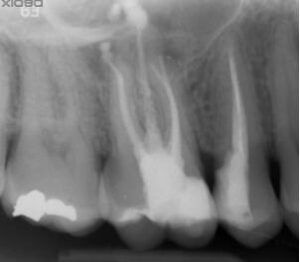Retreatment of an upper first molar with absent canal instrumented with Excalibur® and filled with NeoSealer Flo®
Dr. Noé Hernández receives a patient in his clinic suffering from acute pain in the area of the first quadrant. After performing the appropriate diagnostic tests, it is observed that tooth 16 has been previously treated and currently presents with acute apical periodontitis, which requires reintervention.
After the removal of the canal fillings, the tooth is instrumented with Excalibur® and the previously untreated missed canal is found, then profusely irrigated and filled with the new cement NeoSealer Flo® from Zarc using the single cone technique.
Diagnosis
A patient presenting with acute pain in the area of the first quadrant visits Dr. Noé Hernández’s clinic. Different tests are performed to establish a precise diagnosis:
- Previously treated tooth
- Positive percussion test
- Positive palpation test
- Physiological probing
The final diagnosis is acute apical periodontitis in tooth 16, a previously treated tooth.
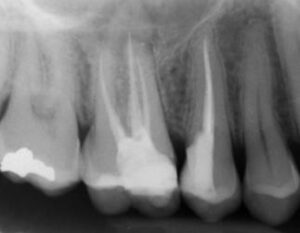
Initial diagnostic x-ray
Non-surgical retreatment
In cases like this, where the initial endodontic treatment is deficient, we always opt for canal retreatment or reendodontics as the first choice, as it allows us to be more conservative and extend the life of the tooth.
The endodontic sequence is performed as follows:
- Removal of the coronal third filling using a Gates Glidden #2 drill, which has a 70 tip size.
- Removal and shaping of the canal with the Excalibur® reciprocating file 35.05 from Zarc until achieving apical patency and measurement with the LEA.
- Searching for the mesiopalatal canal or MB2, which was omitted.
- Measurement and patency of all canals and conformation of the root canal system to 40.05.

Instrumentation with Excalibur® by Zarc
Once we have correctly unblocked and instrumented the main canals, we proceed to locate the missed canal, which in this case was the mesiopalatal canal. To do this, we use ultrasonic tips, carefully wearing down the dentin until we find it.
In an article published by Song et al. in 2011 in the Journal of Endodontics, the omission of canals was one of the main causes of endodontic failure (20%).
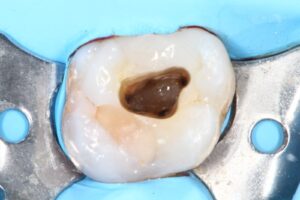
Instrumented and localized canals
Once we have located and instrumented all the canals, we move on to the key phase in retreatments, the intracanal cleaning. Irrigation must be thorough since this is a previously treated tooth with an apical image. Therefore, 4.25% sodium hypochlorite is used in three cycles of 30 seconds of ultrasonic activation with Z-Activator®. Additionally, 17% EDTA is used for 30 seconds with ultrasonic activation.
Subsequently, a cone-fit radiograph is taken to check the apical fit and the canal is then obturated.
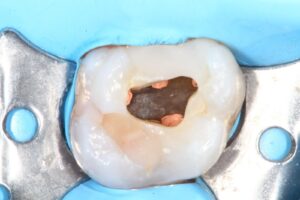
Obturated canals
Obturation with NeoSealer Flo® bioceramic by Zarc
For the obturation, the new NeoSealer Flo® bioceramic cement by Zarc is used with the single cone technique.
The main advantage of these new cements is their ability to set even in moist conditions within the canal, which is helpful in retreatment cases and pulp necrosis.
Finally, the definitive restoration of the case is carried out, and the final postoperative radiograph is taken. A follow-up will be done in 6 months to observe the evolution of the apical lesion.
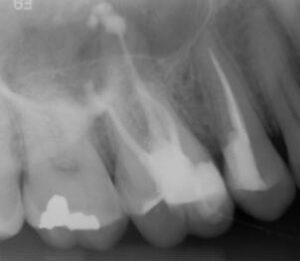
Final X-Rays
